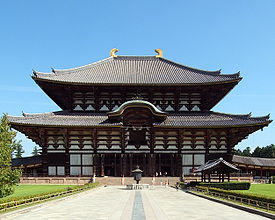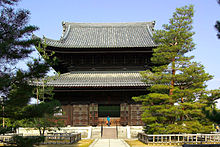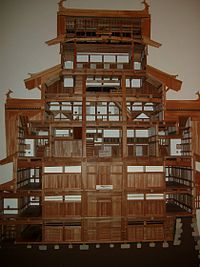- Main Hall (Japanese Buddhism)
-
 Tōdai-ji's latest "Daibutsuden" reconstructed in 1709 is a 9x7 bay Kon-dō (Japan's National Treasure)
Tōdai-ji's latest "Daibutsuden" reconstructed in 1709 is a 9x7 bay Kon-dō (Japan's National Treasure)
Main hall is the term used in English for the building within a Japanese Buddhist temple compound (garan) which enshrines the main object of veneration[1]. Because the various denominations deliberately use different terms, this single English term translates several Japanese words, among them Butsuden, Butsu-dō, kon-dō, konpon-chūdō, and hon-dō. Hon-dō is its exact Japanese equivalent, while the others are more specialized words used by particular sects or for edifices having a particular structure.
Contents
Kon-dō (Asuka and Nara periods)
The term kon-dō (金堂), literally "golden hall", started to be used during the Asuka and Nara periods. A kon-dō is the centerpiece of an ancient Buddhist temple's garan in Japan. The origin of the name is uncertain, but it may derive from the perceived preciousness of its content, or from the fact that the interior was lined with gold[2]. This is the name used by the oldest temples in the country[3].
A kon-dō, for example Hōryū-ji's is a true two-story building with a 3x2 bay central core (moya) surrounded by a 1-bay wide aisles (hisashi (廂) making it 5x4 bays, surrounded by an external 1-bay wide mokoshi, for a total of 9x7 bays[2]. The second story has the same dimensions as the temple's core at the first story, (3x2 bays), but has no mokoshi.[2]
Some temples, for example Asuka-dera or Hōryū-ji, have more than one kon-dō, but normally only one exists and is the first building to be built[3]. Because of its limited size, worshipers were not allowed to enter the building and had to stand outside[2]. The kon-dō and a pagoda were usually surrounded by a corridor called kairō.
The use of kon-dō declined after the 10th century, when it was replaced by a hon-dō divided in naijin (内陣) (inner sanctuary reserved to the deity) and gejin (外陣) (space for worshipers, like the nave in a church)[3]. The term remained in some use even up to the Edo period, but its frequency decreased drastically after the appearance of the term hon-dō in the Heian period [2].
Hon-dō (Heian period)
The term hon-dō (本堂), literally means "main hall"[3][note 1] and it enshrines the most important objects of veneration[2]. The term is thought to have evolved during the 9th century to avoid the early term kondō, at the time used by six Nara sects called the Nanto Rokushū (南都六宗 Nara six sects)[2]. It became common after the introduction of the two Mikkyo sects (Tendai and Shingon) to Japan.[2]
Various new types of temple buildings, including the hon-dō, were built during the Heian period, in response to the requirements of new doctrines. Different buildings were called hon-dō depending on the sect, for example: the kondō (Shingon), the chudō (Tendai), mieidō (Jōdo), the Amida-dō (Shinshu).[4] A notable evolution of the hon-dō during this period is the inclusion of a space for worshipers inside the hon-dō itself, called gejin (see above).[5] [2]
Other names such as Konpon-chūdō (根本中堂), literally "cardinal central hall" are used as well, for example for the main hall at Mount Hiei's Enryaku-ji[note 2][2]. The Tokugawa funeral temple of Kan'ei-ji, which had been built explicitly to imitate Enryaku-ji, also had one, though it has not survived[6]. Yama-dera in Yamagata is another example of a temple using this name.
Butsuden (Kamakura period)
 This single storied Zen butsuden at Myōshin-ji seems to have two stories because of its mokoshi.
This single storied Zen butsuden at Myōshin-ji seems to have two stories because of its mokoshi.
The Butsuden or Butsu-dō (仏殿・仏堂), literally "Buddha Hall", is the main hall of Zen schools such as the Sōtō 曹洞 and Rinzai 臨済[2]. This architectonic style arrived together with Zen during the Kamakura period. Because of its square shape, the Butsuden is also called hōjō. It is at the same time the temple's hon-dō.[note 3] There are following types of Butsuden or Butsu-dō:
- The simplest is a 3x3 bay square building (where "bay" is the space between two pillars, a unit of measurement in Japanese architecture called ken (間) in Japanese and equivalent to between 181 cm and 197 cm) with no mokoshi (裳階) (a mokoshi being an enclosure circling the core of the temple covered by a pent roof, usually one bay in width[2].
- The second type is also 3x3 bay square, but has a 1 bay wide mokoshi all around the core of the temple, making it look like a two-story, 5x5 bay building as in the case of the butsuden, visible in the photo on the right[2].
- It is also known that during the 13th and 14th centuries very large butsuden measuring 5x5 bays square having a mokoshi were built, but none survives[2]. Large size 3x3 bay butsuden with a mokoshi however still exist, for example at Myoshin-ji (see photo in the Gallery section below)[2].
Edo period
In the case of the Obaku 黄檗 Zen school that arrived late in Japan, the architecture retained the Ming China style.[7] The hon-dō of Obaku Zen school temples is usually called daiyu-hōden (大雄宝殿).[6] Examples can be found at Mampuku-ji.
Notes
- ^ The term hon-dō is translated as "main hall" in Japanese-English dictionaries. ("Yahoo!辞書 - ほんどう(本堂". http://dic.yahoo.co.jp/dsearch?enc=UTF-8&p=%E6%9C%AC%E5%A0%82&stype=0&dtype=3.)
- ^ The hall measures 11x6 bays, of which 11x4 are accessible by the public.
- ^ Daitoku-ji, Nanzen-ji and Ryōan-ji, for example.
References
- ^ Kōjien Japanese dictionary
- ^ a b c d e f g h i j k l m n o JAANUS
- ^ a b c d Iwanami Nihonshi Jiten
- ^ "Yahoo! Encyclopedia (Japanese: 本堂 - Yahoo!百科事典)". http://100.yahoo.co.jp/detail/%E6%9C%AC%E5%A0%82/.
- ^ Oota (太田 博太郎) (1999). Nihon Kenchiku Yoshikishi (日本建築様式史). 美術出版社. ISBN 978-4568400502.
- ^ a b Watanabe (2005:30)
- ^ Baroni, Helen Josephine (2000). Obaku Zen: the emergence of the third sect of Zen in Tokugawa Japan. Honolulu: University of Hawai'i Press. p. 98. ISBN 0-8248-2243-9.
- Iwanami Kōjien (広辞苑) Japanese dictionary, 6th Edition (2008), DVD version
- Iwanami Nihonshi Jiten (岩波日本史辞典), CD-Rom Version. Iwanami Shoten, 1999-2001.
- Japanese Art Net User System Dictionary of Japanese Architectural and Art Historical Terminology, Butsuden, Kondou, Hondou entries. ccessed on May 6, 2009
- Watanabe, Hiroshi (April 25, 2001). The architecture of Tokyo. Edition Axel Menges. ISBN 978-3930698936.
See also
- Shichidō garan for details about the main hall's position within a temple compound.
- The Glossary of Japanese Buddhism for terms concerning Japanese Buddhism, Japanese Buddhist art, and Japanese Buddhist temple architecture.
- Mahavira Hall
Gallery
-
Hōryū-ji's kon-dō
(Japan's National Treasure) -
Enryaku-ji's Konponchū-dō
(Japan's National Treasure) -
Mt. Kōya's kon-dō on Danjōgaran
-
Daigo-ji's kon-dō
(Japan's National Treasure) -
Tō-ji's kon-dō
(Japan's National Treasure) -
Sanjūsangen-dō's hon-dō
(Japan's National Treasure)
Elements of Japanese architecture Styles Buddhist · Buke · Daibutsuyō · Gassho · Giyōfū · Hachiman · Hirairi · Hiyoshi (also called Hie) · Irimoya · Ishi-no-ma · Kasuga · Kibitsu · Nagare · Ōbaku Zen · Setchūyō · Shinden · Shinmei · Shinto · Shoin · Sukiya · Sumiyoshi · Taisha · Wayō · ZenshūyōA model of Himeji Castle
Building types Roof styles Structural Burdock piling · Chigi · Disordered piling · Engawa · Fusuma · Hisashi · Irimoya-zukuri · Irori · Jinmaku · Katōmado · Katsuogi · Kuruwa · Mokoshi · Moya · Nakazonae · Namako wall · Nightingale floor · Onigawara · Ranma · Shōji (see also washi) · Sōrin · Tamagaki · Tatami · Tokonoma · Tokyō · Tsumairi · ShibiGates and approaches Rooms Furnishings Outdoor objects Measurements Groups See also Buddhist temples in Japan Japanese Buddhist architecture Architectonic elements Mon (gates) Buildings Chinjusha · chōzuya/temizuya · -dō · main hall (kon-dō, hon-dō, butsuden) · kuri · kyōzō or kyō-dō · shoinTō or Buttō (pagodas) Styles Others A-un · kenSchools and objects of worship Major schools Zen schools Nanto rokushū Objects of worship Amida Nyōrai · Benzaiten · Dainichi Nyorai · Jizō · Kannon · Marishi-ten · Shaka Nyorai · Shitennō (Four Kings) · Twelve Heavenly Generals (Jūni Shinshō) · Yakushi NyoraiOther elements Implements kei (ritual gong) · mokugyōOthers bussokuseki · butsudan · Glossary of Japanese Buddhism · Japanese Buddhist pantheon · jingū-ji · miyadera · saisenbakoCategories:- Buddhism in Japan
- Buddhist art and culture
- Zen
- Japanese architecture
- Japanese architectural features
Wikimedia Foundation. 2010.









